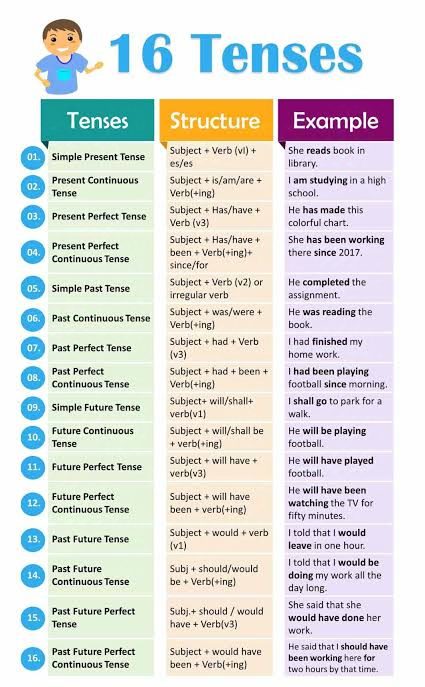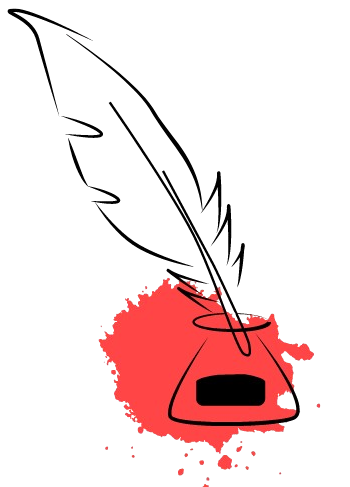Understanding Tenses in English and Hindi
Tenses are crucial in both English and Hindi as they help convey when an action or event happens. Tenses are divided into three main categories: Present (वर्तमान काल), Past (भूतकाल), and Future (भविष्य काल). Each category is further divided into four sub-categories: Simple (साधारण), Continuous (अपूर्ण), Perfect (पूर्ण), and Perfect Continuous (पूर्ण अपूर्ण).

1. Present Tense (वर्तमान काल)
a. Present Simple Tense (साधारण वर्तमान काल)
English: Describes habitual actions, universal truths, and general facts.
Hindi: सामान्य रूप से होने वाली क्रिया या सत्य को दर्शाता है।
Structure:
English: Subject + base form of verb (with “s/es” for third-person singular) + object.
Example: He writes a letter.
Hindi: कर्ता + क्रिया की मूल रूप (ता, ती, ते) + कर्म।
Example: वह पत्र लिखता है।
b. Present Continuous Tense (वर्तमान काल में अपूर्ण क्रिया)
Usage:
English: Describes actions happening right now or temporary actions.
Hindi: वर्तमान समय में हो रही क्रिया को दर्शाता है।
Structure:
English: Subject + is/am/are + verb + ing + object.
Example: He is writing a letter.
Hindi: कर्ता + रहा/रही/रहे + है + कर्म।
Example: वह पत्र लिख रहा है।
c. Present Perfect Tense (पूर्ण वर्तमान काल)
English: Describes actions completed recently or actions with effects in the present.
Hindi: हाल ही में पूरी हुई क्रिया को दर्शाता है।
Structure:
English: Subject + has/have + past participle of verb + object.
Example: He has written a letter.
Hindi: कर्ता + ने + क्रिया की पूर्ण रूप (चुका, चुकी, चुके) + कर्म।
Example: उसने पत्र लिखा है।
d. Present Perfect Continuous Tense (वर्तमान पूर्ण अपूर्ण काल)
English: Describes actions that started in the past and are still continuing.
Hindi: किसी कार्य को जो अतीत में शुरू हुआ और अभी भी जारी है, दर्शाता है।
Structure:English: Subject + has/have been + verb + ing + object + since/for + time.
Example: He has been writing a letter for two hours.
Hindi: कर्ता + रहा/रही/रहे + है/होने + क्रिया की अपूर्ण रूप + से/से/सालों से।
Example: वह दो घंटे से पत्र लिख रहा है।
2. Past Tense (भूतकाल)
a. Past Simple Tense (साधारण भूतकाल)
English: Used for actions that happened at a specific time in the past.
Example: He wrote a letter.
Hindi: अतीत में किसी विशेष समय पर हुई क्रिया।उदाहरण: उसने पत्र लिखा।
Structure:
English: Subject + past form of verb + object.
Hindi: कर्ता + क्रिया (लिखा/लिखी/लिखे) + कर्म।
b. Past Continuous Tense (अपूर्ण भूतकाल)
English: Used for actions that were happening at a specific time in the past.
Example: He was writing a letter.
Hindi: अतीत में किसी समय हो रही क्रिया।
उदाहरण: वह पत्र लिख रहा था।
Structure:
English: Subject + was/were + verb + ing + object.
Hindi: कर्ता + क्रिया (रहा/रही/रहे) + था/थी/थे + कर्म।
c. Past Perfect Tense (पूर्ण भूतकाल)
English: Used for actions that were completed before another action in the past.
Example: He had written a letter before he left.
Hindi: अतीत में किसी और क्रिया से पहले पूरी हुई क्रिया।
उदाहरण: उसके जाने से पहले उसने पत्र लिखा था।
Structure:
English: Subject + had + past participle of verb + object.
Hindi: कर्ता + क्रिया (लिख चुका था/थी/थे) + कर्म।
d. Past Perfect Continuous Tense (भूत पूर्ण अपूर्ण काल) English:
Structure:
Subject + had been + verb + ing + object + since/for + time.
Usage: Describes actions that were happening for a period of time before another action in the past.
Example: He had been writing a letter for two hours before the power went out.
Hindi: Structure: कर्ता + रहा/रही/रहे + था/थी/थे + क्रिया की अपूर्ण रूप + से/से/सालों से।
Usage: किसी अन्य कार्य से पहले जारी थी और समाप्त हुई क्रिया को दर्शाता है।
Example: बिजली जाने से पहले वह दो घंटे से पत्र लिख रहा था।
3. Future Tense (भविष्य काल)
a. Future Simple Tense (साधारण भविष्य काल)
English: Structure: Subject + will/shall + base form of verb + object.
Usage: Describes actions that will happen in the future.
Example: She will write a letter.
Hindi:
Structure: कर्ता + क्रिया (लिखेगा, लिखेगी, लिखेंगे) + कर्म।
Usage: भविष्य में होने वाली क्रिया को दर्शाने के लिए।
Example: वह पत्र लिखेगी।
b. Future Continuous Tense (भविष्य में अपूर्ण क्रिया)
English:
Structure: Subject + will be/shall be + verb + ing + object.
Usage: Describes actions that will be happening at a specific time in the future.
Example: She will be writing a letter.
Hindi: Structure: कर्ता + रहा/रही/रहे + होगा/होगी/होंगे + क्रिया की अपूर्ण रूप + कर्म।
Usage: भविष्य में एक निश्चित समय पर हो रही क्रिया को दर्शाने के लिए।
Example: वह पत्र लिख रही होगी।
c. Future Perfect Tense (पूर्ण भविष्य काल)
English:
Structure: Subject + will have/shall have + past participle of verb + object.
Usage: Describes actions that will be completed before a specific time in the future.
Example: She will have written a letter by tomorrow.
Hindi:
Structure: कर्ता + ने + क्रिया की पूर्ण रूप + होगा/होगी/होंगे + समय।
Usage: भविष्य में किसी समय से पहले पूर्ण होने वाली क्रिया को दर्शाने के लिए।
Example: वह कल तक पत्र लिख चुकी होगी।
d. Future Perfect Continuous Tense (भविष्य पूर्ण अपूर्ण काल)
English:
Structure: Subject + will have been/shall have been + verb + ing + object + since/for + time.
Usage: Describes actions that will have been happening for a period of time by a specific point in the future.
Example: She will have been writing a letter for an hour by the time you arrive.
Hindi:
Structure: कर्ता + रहा/रही/रहे + होगा/होगी/होंगे + समय से/के लिए + समय।
Usage: भविष्य में किसी समय से पहले शुरू होकर जारी रहने वाली क्रिया को दर्शाने के लिए।
Example: आपके आने तक वह एक घंटे से पत्र लिख रही होगी।
Use of ‘is’, ‘am’, ‘are’, ‘have’, ‘been’, ‘were’, etc.
These are auxiliary verbs (helping verbs) in English, used to form different tenses, voices, and moods. Let’s break down their usage:
1. ‘Is’, ‘Am’, ‘Are’:
These are present tense auxiliary verbs used in continuous tenses and passive voice.
‘Is‘: Used with third-person singular subjects (he, she, it).
Example (Present Continuous): He is running.
Example (Passive Voice): The book is written by John.
‘Am‘:Used with the first-person singular subject (I).Example (Present Continuous):
I am studying.
Example (Passive Voice): I am known for my work.
‘Are’:Used with plural subjects (we, you, they).
Example (Present Continuous): They are playing.
Example (Passive Voice): The letters are delivered.
2. ‘Was’, ‘Were’:
These are past tense auxiliary verbs used in continuous tenses and passive voice.
‘Was‘:Used with singular subjects (I, he, she, it) in the past tense.
Example (Past Continuous): She was reading.
Example (Passive Voice): The letter was written by her.
‘Were‘:Used with plural subjects (we, you, they) in the past tense.
Example (Past Continuous): They were sleeping.
Example (Passive Voice): The songs were sung by the choir.
3. ‘Have’, ‘Has’, ‘Had’:
These auxiliary verbs are used in perfect tenses.
‘Have‘:Used with plural subjects (I, we, you, they) and in first and second person.
Example (Present Perfect): They have finished their homework.
‘Has‘:Used with third-person singular subjects (he, she, it).
Example (Present Perfect): She has gone to the market.
‘Had‘:Used with all subjects in the past perfect tense.
Example (Past Perfect): He had completed the task before the deadline
5. ‘Do’, ‘Does’, ‘Did’:
These are used in negative sentences, questions, and emphatic sentences.
‘Do‘:Used with plural subjects (I, we, you, they) in present tense.
Example: I do not like coffee.
‘Does‘:Used with third-person singular subjects (he, she, it) in present tense.
Example: She does not play football.
‘Did‘:Used with all subjects in the past tense.
Example: They did not go to the party.

Get involved!
Comments